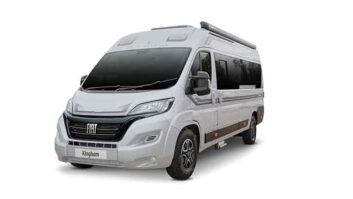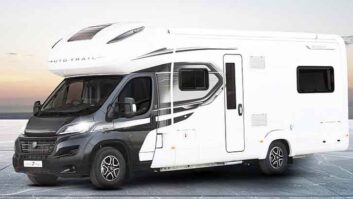A super synergy of two iconic marques: Auto-Sleepers – our oldest volume motorcaravan converter – plus Volkswagen, builder of a base vehicle that is synonymous with van-life, the Transporter.
Despite predictions to the contrary, the world didn’t stop turning when VW launched its ‘revolutionary’ T4 Transporter. ‘Revolutionary’ because VW abandoned the previous drivetrain of a rear engine and rear-wheel drive, for a front engine mounted transversely, driving the front wheels. The Transporter, which features in our best van for a camper conversion guide, is also used for the brand’s California range, and the new T7 is due to come online later this year.
Even the marketing gurus at VW didn’t seem to be totally convinced about its appeal to diehard serial Vee-Dub purchasers, so there was a two-year overlap in which both new T3 and T4 models were offered for sale.
The Auto-Sleeper (elevating-roof) Trooper and (high-top) Trident campers were built on both generations, joined by the Talent on T4.
Prospective buyers were looking for something more akin to the Auto-Sleepers Symphony on Talbot Express/Peugeot Boxer and Duetto on Ford Transit; that is, a panel van conversion with coachbuilt levels of comfort and equipment – now the norm, but not so some 30 years ago.
After a sharp U-turn, VW abandoned its policy of definitely not building a long-wheelbase T4 by… you’ve guessed it… building one. This was the catalyst for Auto-Sleepers to launch the Topaz in 1996, adding its own elegantly realised moulded GRP high-top to the four-door (rear tailgate) T4 derivative.

Layout favoured a forward lounge of twin swivelling cab seats ahead of a nearside face-forward travel seat and an offside inward-facing settee. Moving rearwards, the kitchen straddles the aisle and the full-width changing area/wardrobe/washroom is at the tail end. Cleverly, ‘through’ rearward vision was maintained for the driver, the type of thoughtful addition we look for in the best camper vans.
For the first generation, standard motive power was provided by a 2.0-litre petrol unit, although most purchasers opted for the extra-cost options of the silky-smooth 2.4-litre five-cylinder, naturally aspirated diesel engine, or the autobahn-storming 2.5-litre direct-injection petrol unit.
VW was adamant it was never going to offer a turbodiesel, prompting the popularity of retrofit intercooled turbochargers, mostly by TB Turbo of Lancaster. Another VW U-turn in 1998 unveiled the 2.5TDI unit.

The standard equipment level was high, as reflected in the launch price of £27,373 (2.4D), and even included a set of Auto-Sleeper crockery in a dedicated storage cupboard, so one less thing to remember when kitting out your motorhome. Originally no mugs, only cups and saucers – this is an Auto-Sleeper, after all. Mugs? What would the butler say?
The Carver Cascade water heater was upgraded to the Rapide in 1999, but the Carver P4 blown-air space heater soldiered on until the change to an Eberspächer for 2003. These were plumbed in to the engine’s fuel tank.
The all-new Transporter T5 was launched for the 2003 model year. This was Vee-Dub’s first Transporter with a fascia-mounted gear-lever, replacing the ‘tree trunk’ mounted on the floor. Petrol engines were dropped, although a ‘road-rocket’ 172bhp TDI unit was added.

Auto-Sleepers seized the initiative the new underpinnings provided, by refreshing its contribution, and new Italian furniture and Belgian designer soft furnishing fabrics transformed the interior, which had become a bit dated. No tinkering with the layout, though; that was spot-on from the start.
Topaz disappeared from the sales brochures in early 2006, but (bizarrely) could be obtained as a built-to-order special for a further couple of years.
If you’re thinking of buying a used motorhome, they can make a canny pre-loved purchase and stand up very well against today’s equivalents, both ‘residentially’ and in terms of driver appeal.
What to look out for with an Auto-Sleepers Topaz
Auto-Sleeper Topaz essentials
- Auto-Sleeper Topaz on VW Transporter LWB T4 and T5
- Mass-produced 1996 to 2006 (afterwards to special order for a couple of years) in Willersey, Broadway, Worcestershire
- Four-door steel panel van with Auto-Sleeper moulded GRP high-top
- Overall length: T4: 5.06m (16’ 7.25”), T5: 5.39m (17’ 8.25”)
What we like in the Auto-Sleeper Topaz
- Classy carriage
- Strong residuals
- Coachbuilt comfort in van conversion
- Singles or a double bed
- Rear tailgate
What we don’t like in the Auto-Sleeper Topaz
- High price of some (genuine)
- VW spare parts
Base vehicle
Base vehicles can be an important factor when choosing a used campervan. First, look for a full service history, using only VW-approved lubricants, fluids and coolant.
Early T4 automatics suffered from reliability problems, so be pleased rather than alarmed if a replacement (upgraded) gearbox has been fitted.
Later DSG autos are fantastically reliable and very smooth. Independent rear suspension gives a magic-carpet ride, but can suffer from fatigue.
Additional assistor coils, such as those from MAD (no, really!), should help. VWs have a reputation for being well-built and generally they are.
That said, T4s can suffer from tin worm infestations. Inspect carefully for corrosion and/or bodged repairs.
Conversion
Well screwed together, but still prone to the ravages of time. Check for water ingress and smooth operation of the seat-to-bed conversions.
It’s also wise to keep some foldin’ in reserve, especially for the possible replacement of space and water heaters. Carver ceased production many years ago, although some – but certainly not all – spares are still available if you do a little research.

Have the gas and electrical equipment fully serviced and checked for efficient operation. If money is tight, at least get them safety-checked by a qualified engineer. Fit new smoke and carbon monoxide alarms.
Bear in mind that sadly, the real pitfall for purchasers at entry level is the number of fake Auto-Sleepers around. If in doubt, walk away. Red flags are spelling errors on graphics and dubious cabinetwork.
Our pick
Only one layout and one base vehicle, so it’s all down to condition, really. If there are three motorcaravanners to accommodate, double-check that a folding roof bed has been fitted in lieu of the standard overcab lockers.
What to pay
Strong residuals are a double-edged sword. Slow depreciation means they can’t be bought for buttons. Think in terms of prices starting from £15,000 private, £17,500 trade.
Currently, Auto-Sleepers doesn’t convert VWs (shame), so its nearest equivalent to the Topaz is a Peugeot Boxer-based Kemerton XL, which has an RRP of over £83,000 (OTR).
Alternatives to consider
A more modern option from the same manufacturer is the Auto-Trail V-Line, this time based on a Fiat Ducato – it offers a good range of layouts and some stylish interiors. Coming on a Ford Transit, the Auto-Sleeper Duetto is affordable and practical, while having the benefit of being built to specification, instead of down to price, meaning cabinetwork should be in good order.
If you’ve enjoyed reading this article, why not get the latest news, reviews and features delivered direct to your door or inbox every month. Take advantage of our brilliant Practical Motorhome magazine SUBSCRIBERS’ OFFER and SIGN UP TO OUR NEWSLETTER for regular weekly updates on all things motorhome related.





















